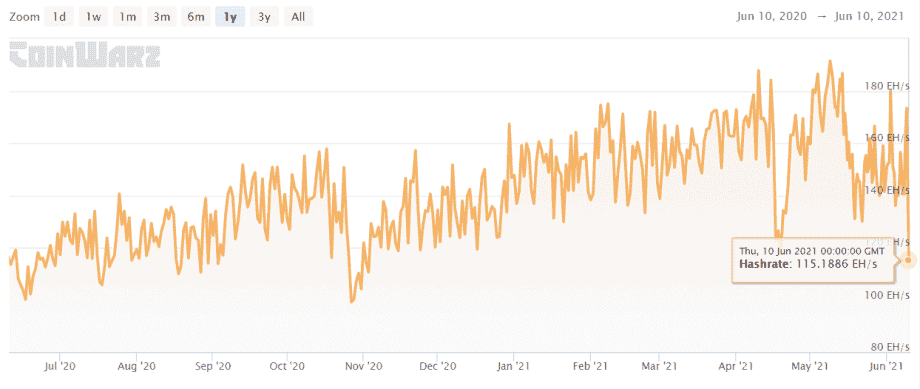Chinese Bitcoin miners are increasingly facing difficulties – at least if they rely on fossil fuels. New measures prohibit more miners from mining BTC. The hashrate has fallen sharply.
Local governments in China continue to crack down on Bitcoin mining farms. Like the crypto news portal Crypto Potato citing the local Chinese newspaper South China Morning Post reports, in addition to mining farms in the provinces of Xinjiang and Qinghai, farms in Yunnan are now also to be shut down. According to this, miners in the Zhundong economic and technology development zone in Xinjiang are affected. The area is located in the autonomous prefecture of Changji Hui and is one of the coal-richest regions in the country. Since 2005, the Zhundong industrial region has been targeting black gold economically. Coal power, electricity, metallurgy and coal chemistry were among the in February 2019 main industries in the economic zone.
But apparently not only black, but also digital gold was mined in Zhundong. Because according to the note from the The block cited, the local government has asked the Bitcoin miners in Zhundong to cease their activities until June 9th, 11:00 a.m. The background to the order is therefore that of the National Reform and Development Commission of China adopted “Measures for the examination of energy saving in fixed investment projects”. These aim, among other things, to “promote the scientific and rational use of resources in investment projects, to eliminate energy waste at the source, to increase energy efficiency and to strengthen the management of total energy consumption”.
Total ban in Qinghai
Meanwhile, Bitcoin miners in Qinghai Province also have to throw their ASICs in the grain. This emerges from an order of the local State Office for Industry and Information Technology, the The block– Reporter Wolfie Zhao shared on Twitter Has.
It says:
It is strictly forbidden to initiate and approve different “mining” projects for virtual currencies in different regions, [ferner sind] Completely close all existing “mining” projects for virtual currencies.
Compared to Xinjiang, Qinghai plays a negligible role in the global Bitcoin mining business. In April 2020, the province provided just 0.26 percent of the total hashrate sponsored by China.
Fourth largest BTC mining region also affected
The southern Chinese province of Yunnan is considered to be one of the poorest regions in the country, but is in fourth place in the ranking of the top Bitcoin mining regions. It has now become known that over the weekend, Chinese authorities have started investigations against individuals and companies for illegal use of the electricity grid because they had used it to mine Bitcoin. Like the portal Crypto Potato reported, they are now threatened with being cut off from the grid.
By the end of June, those Bitcoin miners that pose “security risks to the power grid” would be shut down, according to the Chinese authorities.
Bitcoin hashrate is weak
At the time of going to press, the Bitcoin hashrate recorded a significant drop in a 24-hour comparison. At around 111 EH / s, the hashrate is at its lowest level since November 2020.
China and Bitcoin: It remains ambivalent
Due to the strong temporal correlation between the hashrate collapse and the shutdown of the mining operations in Zhundong, a causal relationship cannot be ruled out. However, it was last shown in April that the hashrate can quickly recover from such drops. In addition, the Chinese government seems to be targeting mining farms with coal-powered electricity. Bitcoin mining, which relies on renewable energies, is therefore not affected. On the contrary: As an insider told BTC-ECHO, China even wants to become a pioneer in the field of sustainable Bitcoin mining.
The Bitcoin course seems to have coped with the supposed horror news of the hashrate slump so far – with a daily increase of almost 7 percent, BTC is still defying the prophecies of doom.
This article was initially published on April 10th. The current version has been reviewed and updated at the time of writing.
